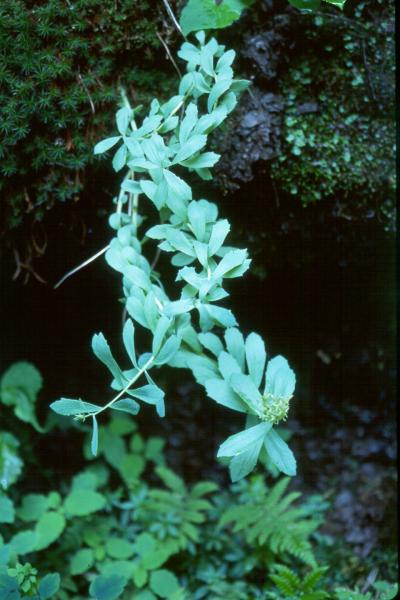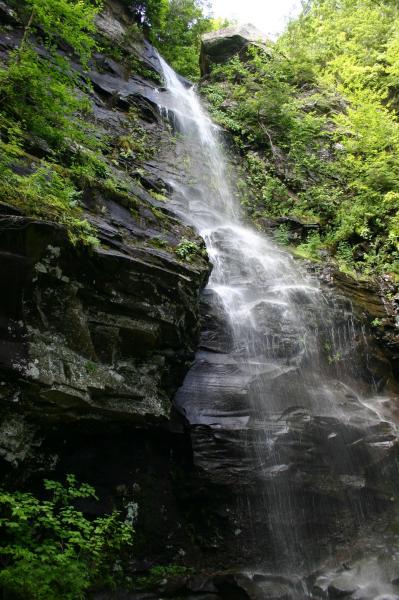Common Roseroot
Rhodiola rosea L.
- Class
- Dicotyledoneae (Dicots)
- Family
- Crassulaceae (Stonecrop Family)
- State Protection
- Endangered
Listed as Endangered by New York State: in imminent danger of extirpation in New York. For animals, taking, importation, transportation, or possession is prohibited, except under license or permit. For plants, removal or damage without the consent of the landowner is prohibited.
- Federal Protection
- Not Listed
- State Conservation Status Rank
- S1
Critically Imperiled in New York - Especially vulnerable to disappearing from New York due to extreme rarity or other factors; typically 5 or fewer populations or locations in New York, very few individuals, very restricted range, very few remaining acres (or miles of stream), and/or very steep declines.
- Global Conservation Status Rank
- G5
Secure globally - Common in the world; widespread and abundant (but may be rare in some parts of its range).
Summary
Did you know?
Roseroot has been used as a medicinal plant for improving physical and mental performance. In Siberia it has been used to help resist the effects of extreme cold. It is now being used to treat cases of mild or moderate depression (Rhodiola rosea in Wikipedia, web site accessed 21 November 2007). When it is dried the root has a strong smell of roses (Rhodiola rosea in Plants for a Future, web site accessed 21 November 2007).
State Ranking Justification
There are four existing populations that are isolated and under little threat. There are no additional historical records. More populations could be discovered in the Catskill Mountains as additional remote ravines are explored.
Short-term Trends
Short-term trends seem stable since populations are isolated and of sufficient numbers to persist.
Long-term Trends
This species was always rare in New York with only a few populations statewide. These populations have continued to persist for the last 50-100 years.
Conservation and Management
Threats
Natural rock falls may reduce populations.
Conservation Strategies and Management Practices
Establish sufficient buffers around populations to preserve the undisturbed aspect and hydrology of their habitat.
Habitat
Habitat
Roseroot has been found at only a few sites in New York, all of them cliffs, and all but one near waterfalls. The species appears to prefer shaded and cool sites. It occupies cliffs of both calcareous and acidic rock (New York Natural Heritage Program 2007). Rocky coast and sea cliffs, locally inland (Fernald 1970). Cliffs and ledges (Gleason & Cronquist 1991).
Associated Ecological Communities
- Calcareous cliff community
(guide)
A community that occurs on vertical exposures of resistant, calcareous bedrock (such as limestone or dolomite) or consolidated material; these cliffs often include ledges and small areas of talus.
- Cliff community
(guide)
A community that occurs on vertical exposures of resistant, non-calcareous bedrock (such as quartzite, sandstone, or schist) or consolidated material; these cliffs often include ledges and small areas of talus.
Associated Species
- Adiantum pedatum (maidenhair fern)
- Aquilegia canadensis (wild columbine, red columbine)
- Arabidopsis lyrata
- Asplenium trichomanes
- Betula alleghaniensis (yellow birch)
- Campanula rotundifolia (hare-bell)
- Chelidonium majus (greater celandine)
- Cystopteris bulbifera (bulblet fern)
- Diervilla lonicera (bush-honeysuckle)
- Galium aparine (cleavers)
- Geranium robertianum (herb-Robert)
- Hydrocotyle americana (American marsh-pennywort)
- Impatiens capensis (spotted jewelweed, spotted touch-me-not)
- Myosotis scorpioides (water forget-me-not)
- Parthenocissus quinquefolia (Virginia-creeper)
- Phegopteris hexagonoptera (broad beech fern)
- Prenanthes trifoliolata
- Ranunculus hispidus var. caricetorum
- Ribes glandulosum (skunk currant)
- Rubus phoenicolasius (wineberry)
- Sphagnum
- Thuja occidentalis (northern white cedar, arbor vitae)
- Tsuga canadensis (eastern hemlock)
- Woodsia alpina (alpine woodsia, alpine cliff fern)
- Woodsia obtusa
Range
New York State Distribution
Roseroot is found at scattered locations in the northern Catskills, and at a single site in Madison County.
Global Distribution
This species is found from northeastern Canada, including Nunavut, Quebec, and the Atlantic Provinces, south to New York, Vermont, southern New England, Pennsylvania, and New Jersey. From New Jersey it is disjunct to North Carolina (and considered extirpated in Tennessee), and known in the western states only from Utah.
Identification Comments
General Description
Roseroot is a fleshy-leaved, perennial wildflower, in our area growing right out of cracks in rock ledges or cliffs. It has a thick, scaly root, from which emerge stems 10-40 cm long. The leaves are short (1-4 cm long), sessile, and alternate, sometimes crowded enough that they seem to form a spiral up the stem. The plants are dioecious, meaning an individual plant has either male flowers or female ones, but not both. The male plants have star-shaped flowers with 5 (sometimes fewer) bright yellow, tiny (2-4.5 mm) petals. The female flowers are less conspicuous, each with 5 yellow-green ovaries tapering into the pointed styles.
Best Life Stage for Proper Identification
Roseroot is most easily identified when in flower.
Similar Species
The only other species of Rhodiola in New York, Leedy's Roseroot, has wider, red petals (sometimes yellow at their bases). There are several species of Sedum (stonecrops) in New York State with yellow flowers and fleshy leaves, but these are all creeping or prostrate mat forming, species, and their flowers are perfect (with both male and female parts).
Best Time to See
Roseroot flowers from mid-May through June.
- Vegetative
- Flowering
- Fruiting
The time of year you would expect to find Common Roseroot vegetative, flowering, and fruiting in New York.
Common Roseroot Images
Taxonomy
Common Roseroot
Rhodiola rosea L.
- Kingdom Plantae
- Phylum Anthophyta
- Class Dicotyledoneae
(Dicots)
- Order Rosales
- Family Crassulaceae (Stonecrop Family)
- Order Rosales
- Class Dicotyledoneae
(Dicots)
- Phylum Anthophyta
Additional Common Names
- Pink Sedum
Synonyms
- Sedum rosea (L.) Scop.
Additional Resources
Best Identification Reference
Gleason, Henry A. and A. Cronquist. 1991. Manual of Vascular Plants of Northeastern United States and Adjacent Canada. The New York Botanical Garden, Bronx, New York. 910 pp.
Other References
Clausen, R.T. 1975. Sedum of North America north of the Mexican Plateau. Cornell University Press, Ithaca, New York. 742 pp.
Clemants, Steven and Carol Gracie. 2006. Wildflowers in the Field and Forest. A Field Guide to the Northeastern United States. Oxford University Press, New York, NY. 445 pp.
Fernald, M.L. 1950. Gray's manual of botany. 8th edition. D. Van Nostrand, New York. 1632 pp.
Haines, Arthur and Thomas F. Vining. 1998. Flora of Maine. A Manual for Identification of Native and Naturalized Vascular Plants of Maine.
Holmgren, Noel. 1998. The Illustrated Companion to Gleason and Cronquist's Manual. Illustrations of the Vascular Plants of Northeastern United States and Adjacent Canada. The New York Botanical Garden, Bronx, New York.
New York Natural Heritage Program. 2010. Biotics database. New York Natural Heritage Program. New York State Department of Environmental Conservation. Albany, NY.
New York Natural Heritage Program. 2024. New York Natural Heritage Program Databases. Albany, NY.
Newcomb, Lawrence. 1977. Newcomb's Wildflower Guide: An Ingenious New Key System for Quick, Positive Field Identification of the Wildflowers, Flowering Shrubs, and Vines of Northeastern and North-Central North America. Little, Brown and Company. Boston.
Rhoads, Ann F. and Timothy A. Block. 2000. The Plants of Pennsylvania, an Illustrated Manual. University of Pennsylvania Press, Philadelphia, PA.
Weldy, T. and D. Werier. 2010. New York flora atlas. [S.M. Landry, K.N. Campbell, and L.D. Mabe (original application development), Florida Center for Community Design and Research http://www.fccdr.usf.edu/. University of South Florida http://www.usf.edu/]. New York Flora Association http://newyork.plantatlas.usf.edu/, Albany, New York
Weldy, Troy W. and David Werier. 2005. New York Flora Atlas. [S.M. Landry, K.N. Campbell, and L.D. Mabe (original application development), Florida Center for Community Design and Research. University of South Florida]. New York Flora Association, Albany, NY. Available on the web at (http://newyork.plantatlas.usf.edu/).
Links
About This Guide
Information for this guide was last updated on: December 29, 2008
Please cite this page as:
New York Natural Heritage Program. 2024.
Online Conservation Guide for
Rhodiola rosea.
Available from: https://guides.nynhp.org/common-roseroot/.
Accessed July 27, 2024.

